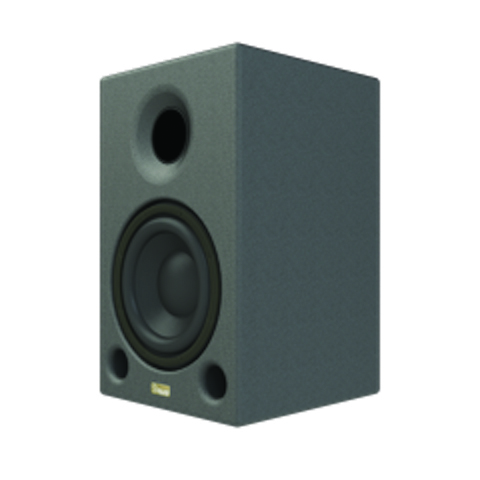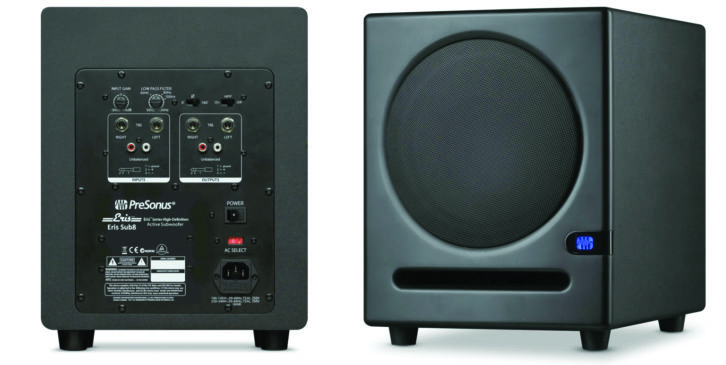The Year of the Sub
Whether it has to do with the pandemic and the demand from engineers for home-studio improvements, or whether it’s just a coincidence, a number of new subwoofers have debuted in the past year. Here’s a look at a few of them, along with a few notable near-fields.
Danley Studio Sub 2
 Danley recently introduced the Studio Sub 2, the second addition to its studio monitor line. Compact and self-powered, the Danley Studio Sub 2 is said to deliver the same clarity and impact to all genres of recording situations as earlier iterations of Danley speakers in the installation and live sound markets. Designed by Tom Danley, it incorporates onboard processing and passive synergy crossover technology. With 112 dB SPL continuous and 122 dB SPL peak, the 65-pound monitor is intended for use in any studio environment having analog, digital-balanced XLR inputs and RCA inputs. The driver complement includes 1 x 10-inch long excursion woofer and 1 x 6.5 co-ax mid/high.
Danley recently introduced the Studio Sub 2, the second addition to its studio monitor line. Compact and self-powered, the Danley Studio Sub 2 is said to deliver the same clarity and impact to all genres of recording situations as earlier iterations of Danley speakers in the installation and live sound markets. Designed by Tom Danley, it incorporates onboard processing and passive synergy crossover technology. With 112 dB SPL continuous and 122 dB SPL peak, the 65-pound monitor is intended for use in any studio environment having analog, digital-balanced XLR inputs and RCA inputs. The driver complement includes 1 x 10-inch long excursion woofer and 1 x 6.5 co-ax mid/high.
KRK Studio Subwoofers

KRK Systems has expanded its range of studio gear with a new generation of powered subwoofers, available in 8-, 10- and 12-inch varieties. The S8.4, S10.4 and S12.4 subwoofers deliver tight, accurate and defined bass, while the highly efficient Class D power amplifiers dramatically increase transient response, control and punch. The redesigned cabinets feature a more compact profile, allowing for improved performance and a more professional aesthetic. Additional refinements include improved low-frequency extension, improved porting for enhanced low-frequency phase response and less port noise, as well as a four-position crossover frequency selection switch, making it easy to adjust the subwoofer’s settings to optimally match existing monitors. Connectivity options include XLR, 1/4-inch TRS and RCA inputs and outputs that interface with just about any manufacturer’s studio monitors, mixers and/or audio interfaces. (See Mix Product Review, Page 40.)
Ocean Way Audio S10A Subwoofer

The new S10A subwoofer from Allen Sides’ Ocean Way Audio was primarily designed as a low-frequency companion to the company’s HR5 Reference Monitor or as a perfect companion for any high-quality nearfield/midfield monitoring system. The S10A features stereo XLR input and output connectors, along with a variety of parameter adjustments, including gain, LF adjust, adjustable crossover and delay, and a 12V trigger input/output for power conservation and other applications. The S10A covers the low-end spectrum with a frequency range of 20 Hz to 120 Hz. It includes a 300W amplifier that can generate 110dB SPL.
PhantomFocus PFMn ICE Cube-12 Subwoofer

The PFM ICE Cube-12 Subwoofer anchors the sonic footprint of the PhantomFocus System but can be used in any application. Designed with ICE Power amplifier technology developed by Bang & Olufsen, the PFM ICE Cube-12 Subwoofer includes a 12-inch long-throw, audiophile grade paper-coned driver, along with a massive magnet motor structure and cast aluminum frame. The simple design employs a powerful DSP solution for crossover and driver control, as well as maintains a low-distortion output by preventing signal overload. The cabinet is built with 3/4-inch medium density fiberboard that has been internally laminated with a 1/8-inch aluminum substrate bracing mechanism for ultra-rigidity. Dimensions are 15.75 x 15.75 x 15.75 inches (HWD) and it weighs 55 pounds. Max Continuous SPL is 120 dB; 700 Watts power; Low Pass Filter 40-140 Hz with LFE Bypass; 0-180 Phase Switch; L&R Line Level RCA/PFS Balanced XLR input; black high-gloss finish.
PreSonus Eris Sub8 Subwoofer

PreSonus has introduced its new Eris Sub8 subwoofer, intended for use in home recording, gaming and home theater setups. The subwoofer is particularly intended to complement the voicing and frequency response of Eris-series media reference monitors such as the Eris E3.5, E3.5 BT, E4.5, or E4.5 BT.
Driven by an onboard 100-watt Class A/B amplifier, the Eris Sub8 delivers low end down to 30 Hz—a full 50 Hz below the Eris E3.5s. It extends the reach of Eris E3.5 or E4.5 monitors in a manner appropriate to smaller rooms.
The subwoofer configures to users’ mixing and listening needs, connecting to full-range monitors via 1/4-inch TRS or RCA, with an input level control and a polarity invert switch. It offers a highpass filter switch and variable lowpass filter/crossover control to help ensure the subwoofer starts working at the precise low-frequency point where users’ full-range monitors drop off.
The PreSonus Eris Sub8 subwoofer is available now for a U.S. street price of $199.95.
New, Notable Near-Field Monitors
ADAM Audio T8V Studio Monitor
The ADAM Audio T8V studio monitor, released in Spring 2020, features an eight-inch woofer paired with powerful amplification, while its lower bass extension makes it an ideal choice for project and home studios. Frequency response reaches down to 33 Hz, with an impressive SPL of 118 dB per pair. Its U-ART (Unique Accelerated Ribbon Tweeter) is mated to a sophisticated waveguide with the same dispersion-control attributes as the HPS waveguide in the S Series. The Class D amplifiers for tweeter and woofer offer ample power for the 8-inch woofer, delivering 20 W and 70 W respectively.
All T Series models feature a beveled cabinet design, rear-firing bass reflex port, built-in DSP-controlled driver crossovers and equalization, and multi-way analog connections.
Focal Alpha 50 Evo, Alpha 65

Focal enters the affordable speaker range in a big way with last month’s release of the Alpha 50 Evo and Alpha 65 Evo, offering excellent sound coherence no matter where a user is listening. Each boasts a new 6.35mm TRS input jack, in addition to the XLR and RCA analog inputs, an automatic standby mode that can now be switched off by the user, and inserts for wall and ceiling fastening. Each is also equipped with two class D amplifiers. The monitors feature a 5/8-inch (15mm)-thick MDF cabinet and incorporate internal braces to ensure it is highly robust, even at the highest levels of acoustic pressure. The bass-reflex design has been used to ensure easy acoustic integration in even the most cramped spaces.
Genelec 1235A Smart Active Monitor

Last Spring, Genelec released the 1235A Smart Active Monitor, which fuses the sound and heritage of the 1035 main monitor with high-performance 96 kHz processing and the ability to adapt to any space through its tight integration with Genelec’s GLM calibration software. With a short-term SPL of 130 dB and low-frequency extension down to 29 Hz, the 1235A delivers power. The 12.36 cubic foot (350-liter) enclosure matches exactly the dimensions of the 1035, and features dual high-performance 15-inch drivers, dual five-inch midrange drivers and a low distortion one-inch throat compression driver. The 1235A’s remote-mountable RAM XL electronics module contains power amplification, crossovers and processing, with Class D amplification delivering 2000 W, 800 W and 250 W for the LF, MF and HF drivers, respectively..
JBL 4349 Studio Monitors

In July 2020, JBL debuted its new JBL 4349 Studio Monitor, bringing together a JBL D2415K dual 1.5-inch driver, a large-format, High-Definition Imaging (HDI) horn and a 12-inch cast-frame, Pure-pulp woofer cone into a monitor intended for both professional and consumer use. The D2415K compression driver features a pair of lightweight, polymer, annular diaphragms with reduced diaphragm mass. The 12-inch (300 mm) woofer and the three-inch (75 mm) long-throw voice coil in conjunction with dual opposing spider dampers are designed for getting loud while reducing distortion. High-frequency and Ultra High-frequency attenuator controls allow sound to be tailored to the specific environment and listener preference. The controls manage a crossover network design that features air-core inductors, cast wire-wound resistors and low-ESR metallized film capacitors in a multi-cap configuration.
PreSonus Eris E7 XT

PreSonus expanded the Eris XT Series in 2020 with the addition of the E7 XT, which employs a 6.5-inch woofer and is intended for use in mid-to-large studio spaces. The 6.5-inch woofer is housed in a ported enclosure yielding a response rated down to 42 Hz, while the 1.25-inch, silk-dome, high-frequency driver is mounted on the EBM waveguide. The E7 XT is Class AB bi-amplified, with a 70-watt amplifier for the LF driver and a 60-watt amp for the HF driver. Maximum SPL is said to be 104 dB. Rear-panel features include an IEC power receptacle with mains fuse, XLR, TRS and RCA input jacks a power switch, and a series of controls for modifying the frequency response of the monitor.
Yamaha MSP3A Compact Powered Speaker

Yamaha‘s new MSP3A powered monitor builds on the company’s MSP3 model and shares its predecessor’s use of multiple input connectors, controls and compatibility with optional brackets, while adding enhanced audio quality and increased sound pressure levels, straightforward operation and a compact, lightweight cabinet design. The MSP3A is the first Yamaha reference monitor to include the company’s Twisted Flare Port technology, designed to provide overall faithful sound reproduction with clearer and tighter low-end frequencies. A built-in 22W power amplifier is optimized for the speaker unit, comprising a 10cm (4-inch) woofer and a 2.2cm (0.8-inch) tweeter. The cabinet features a refined, simple design and weighs only 3.6 kilograms (7.9 pounds), improving portability and making it easier to reposition the unit in different room configurations.






